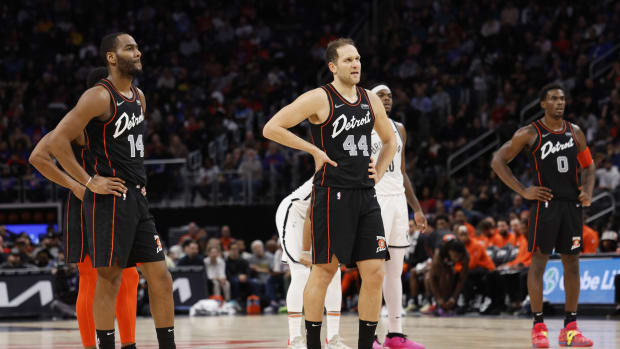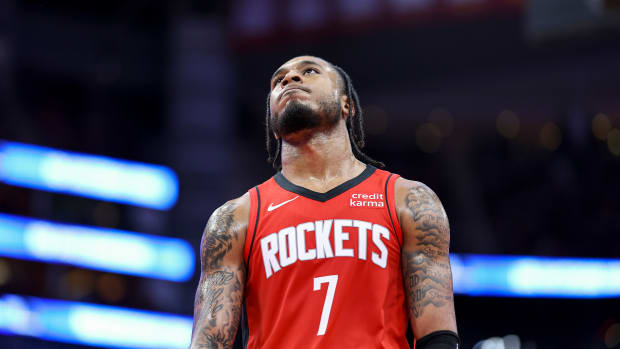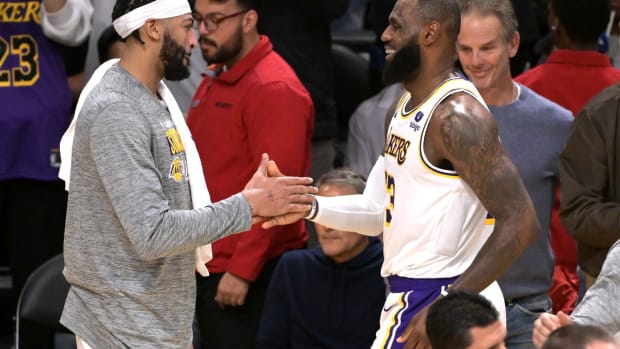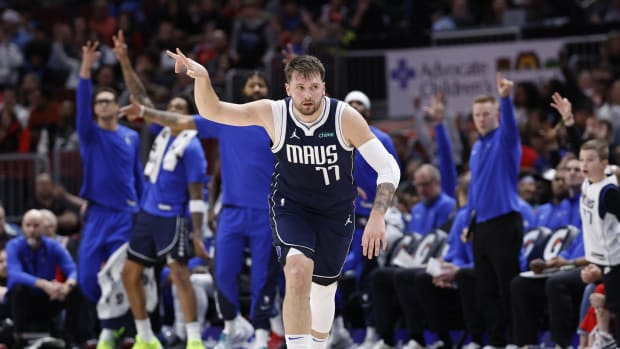Five Mid-Major NBA Draft Prospects to Watch
Not every small-school prospect can be Ja Morant, who has taken college basketball by storm at Murray State, but every year there are players who emerge at less-heralded programs and put themselves on the map in the minds of NBA scouts.
The nature of recruiting and player distribution is imperfect, and as a result, there are always high-major talents who end up at smaller schools (and vice-versa) by way of circumstance. NBA teams canvass the country year after year in hopes of mining value from unusual places, and doing their diligence for present and future drafts. With that in mind, here are five mid-major prospects who are quietly drawing NBA interest, and who are worth keeping tabs on.
Neemias Queta, Utah State, C | Freshman
Height: 6’11” | Weight: 240 | Age: 19
Although his game-to-game effectiveness has waxed and waned, it hasn’t taken long for Queta to establish some degree of buzz among NBA teams. The Portuguese import appears to be a sneaky get for Utah State, after putting himself on the radar playing for Portugal’s U20 national team last summer. Queta picked the Aggies and turned down schools including Texas Tech and Creighton, and as a mobile center with a reported 7’5” wingspan and 9’6” standing reach, he has obvious long-term appeal (emphasis on long) as an NBA prospect. Of course, when evaluating young bigs with those type of physical tools, teams tend to project long-term and give some benefit of the doubt.
Through his first 15 games, Queta averaged 15.3 points, 12.6 rebounds and 3.7 blocks per-36 minutes. He also averaged a far less-impressive five fouls per-36, which is part of why he’s only been playing 23 minutes per game. All of those things are somewhat predictable based on his long and slender body type, and at this stage, you’re taking the good with the bad. He’s learning on the fly, but Queta’s motor has been impressive, as evidenced by his productivity on the glass and as a finisher. He does well contesting vertically, can play above the rim despite not being wildly explosive off the floor, and moves fluidly covering ground away from the basket. On the other side of the floor, Queta’s length and nimble feet offer some promise, and although he’s highly unpolished, his potential as a defender helps couch the average offensive projection with respect to his long-term value projection.
Queta’s primary sell is going to come on the defensive end regardless, where his shot-blocking instincts and physical profile more or less scream first-round caliber. He doesn’t space the floor at all, but mobile rim protectors with upside still fit into a useful role. It is worth noting, though, that in addition to being relatively raw, Queta is old for his class and turns 20 in July. He’s nowhere near ready to help an NBA team, and would likely benefit from a year to work on his game, but smart teams will do their diligence this season, given the possibility he tests the waters. It’s certainly possible a late first-round promise from an interested team looking to cultivate a big on a rookie contract could keep him in the draft (a handful of true fives are already projected as first-rounders, which likely complicates his immediate potential to climb upward). Regardless, assuming he goes back to school, Queta will be a priority for teams going into the 2020 draft.
Yoeli Childs, BYU, F/C | Junior
Height: 6’8” | Weight: 225 | Age: 20
After testing the NBA waters last season, Childs (who turns 21 on Jan. 13) returned for his junior season and has been one of the most productive players in the country. The Cougars play through him a great deal, and Childs’s brawny build, 7’0” wingspan and huge hands have made him a dominant force within the framework of the college game. He’s been an elite rebounder essentially since setting foot on campus, and his consistently high effort and physical development have manifested in the form of double-double production and high efficiency around the basket. Childs’s combination of tools, intangibles, and potential for improvement on his jumper make him a worthy candidate for the second round of the draft.
NBA Big Board 3.0: Ja Morant Slides Into the Top 3 Draft Slots
The “energy big” archetype has shifted somewhat over the years, as there is a greater emphasis on frontcourt players being able to space the floor and defend on the perimeter. Power forward has become a fungible position in some ways due to the wide variety of skill sets that can now occupy that spot. That rebounding specialists of different shapes and sizes have remained relevant—Ed Davis has made a career out of simply hitting the glass, and Montrezl Harrell is blossoming in a significant role for the Clippers—leaving some hope for Childs, who is more of a traditional, bruising body on the inside, but has the length and defensive verticality to play bigger than his listed 6’8” height. He is not a prolific shot blocker, nor is he a high-end leaper, but he should be able to play through contact and contest enough to stay on the floor. The issue is that Childs’s defensive functionality may wind up being matchup-based, and limited to bigs who can’t take him out to the perimeter and attack him. His athleticism may become a limitation as his strength becomes less of… a strength.
This is the story for many a college big man, of course, but if Childs can become a more consistent jump shooter, he will maximize his opportunity to find an NBA role. His three-point shooting (27% as of Wednesday) is down a bit from last season, but he’s taking more of them per game and has upped his free throw percentage to 72%. Simply being able to pick and pop effectively would add a dimension to his offensive game. Already a capable finisher, Childs is making a concerted effort to expand his offense, which leaves some room for optimism. It’s not necessarily likely, but also not out of the question that he would receive a combine invitation, and it will make sense for him to test the waters once more and feel out the interest from teams. When penciled into a smaller role, Childs’s strengths should warrant a real look.
Jalen Pickett, Siena, G | Freshman
Height: 6’4” | Weight: 190 | Age: 19
Pickett is quietly amidst one of the more impressive individual seasons by any freshman, at least statistically, and has put himself on the long-term NBA radar with a combination of positional size and playmaking ability. A native of Rochester, N.Y., Pickett was such an unheralded recruit that he does not even have a profile on major recruiting websites like ESPN and 247 Sports, despite playing for a Nike program and receiving plenty of exposure. Academic issues that contributed to him doing a postgraduate season at SPIRE Institute in Ohio may have also led to the lack of attention from schools. Pickett is already leading the MAAC in assists per game, and his ability to score, distribute and defend make him a person of interest.
Despite rarely ever resting (he’s played more than 90% of possible minutes this season), Pickett has been impressively efficient. He’s long and agile, but is not much of an eye-test guy due to a boxier torso and the fact he’s not exceptionally smooth off the dribble, which limits his ability to create shots for himself and attack the paint. Pickett’s shot mechanics aren’t especially smooth either, but he’s shot exceptionally well off the bounce and consistently been a threat from the perimeter, and his drive-and-kick game and ability to find cutters and rollers on the move is certainly impressive. He should be viewed as a long-term prospect with respect to the draft as his game continues to evolve, and as it becomes clearer how good he projects to be as a shooter and scorer.
Sandy Cohen III, Wisconsin Green-Bay, G/F | Senior
Height: 6’6” | Weight: 200 | Age: 23
No, not the fictional dad from The O.C.: basketball Sandy Cohen is an extremely deep sleeper in the midst of a huge season for the Green Bay Phoenix. Cohen transferred from Marquette in midst of the 2016-17 season and has led Green Bay to an undefeated start in conference play, functioning in a sort of point forward role that has tasked him with distributing, rebounding and creating his own offense. The clear point of skepticism here is that Cohen turns 24 in September, but as a bigger guard with playmaking skills who’s shooting 40% from three and 77.9% from the line, he appears worthy of an opportunity, though unlikely to be drafted.
Cohen is a smooth athlete with a good feel for attacking defenses, with a developed pull-up game and a clean release. With his jumper, ability to grab-and-go with the ball off the glass, and defensive length, he may still have a small window to prove himself to NBA teams, with a training camp invite not out of the question. In the past, Cohen has been criticized for his lack of assertiveness, an issue that seems to have been mitigated somewhat by his significant role in the offense. Again, as a fifth-year senior, his production comes with some grain of salt, but he has consistently filled up the stat sheet on both ends of the floor for a team that has a legitimate chance to win its conference. Expect a Portsmouth Invitational, which would give Cohen the platform he needs to earn NBA workouts and try to sneak in the back door.
Jordan Ford, St. Mary’s, G | Junior
Height: 6’1” | Weight: 175 | Age: 20
A shifty, high-scoring guard enjoying a breakout season, Ford’s offensive game belies his size. While transitioning from secondary option to offensive focal point, he has been among the most efficient scorers anywhere in the country, generating the majority of his looks playing off high ball screens and bombing from outside while averaging north of 22 points per game. There are obvious questions at a glance about his lack of size and strength, but his quick release and ability to pull up from deep at least give him a pathway to earning pro looks if he can continue to do it efficiently. Ford pairs his potent perimeter shooting with a good level of touch and skill finishing in the paint, using a consistent floater and a good sense of angles as a legitimate counter to keep defenses honest. He is not physically imposing in any way, but he’s been prolific at what he does all season, to the point that you have to start taking him seriously.
WOO: Nassir Little, UNC and the challenge of scouting
While it is exceedingly difficult for small, score-first guards in his mold to stick in the NBA, Ford’s skill level and optimal scoring profile for his role bear monitoring. He’s not an exceptional playmaker, but can run pick and roll and make the right play when necessary—his assist numbers may actually be deflated by the St. Mary’s system, which keeps its guards in motion and optimizes Ford as a scoring threat, as opposed to asking him to create for others. Defensively, he’s not likely to provide much. Based on his size and the questions surrounding what will translate, Ford likely tests the waters and ends up in the 2020 draft class. His quickness, scoring feel and quick trigger make make him a player to file away for later.




































